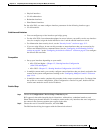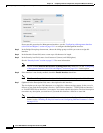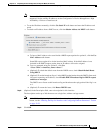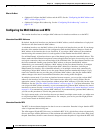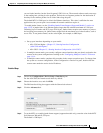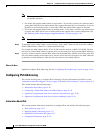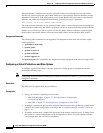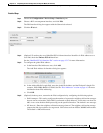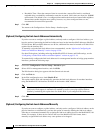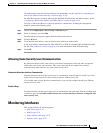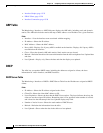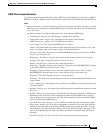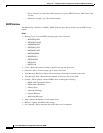
15-17
Cisco ASA 5500 Series Configuration Guide using ASDM
Chapter 15 Completing Interface Configuration (Transparent Mode, 8.4 and Later)
Completing Interface Configuration in Transparent Mode (8.4 and Later)
IPv6 Addressing
You can configure two types of unicast addresses for IPv6:
• Global—The global address is a public address that you can use on the public network. This address
needs to be configured for each bridge group, and not per-interface. You can also configure a global
IPv6 address for the management interface.
• Link-local—The link-local address is a private address that you can only use on the
directly-connected network. Routers do not forward packets using link-local addresses; they are
only for communication on a particular physical network segment. They can be used for address
configuration or for the ND functions such as address resolution and neighbor discovery. Because
the link-local address is only available on a segment, and is tied to the interface MAC address, you
need to configure the link-local address per interface.
At a minimum, you need to configure a link-local address for IPv6 to operate. If you configure a global
address, a link-local addresses is automatically configured on each interface, so you do not also need to
specifically configure a link-local address. If you do not configure a global address, then you need to
configure the link-local address, either automatically or manually.
Duplicate Address Detection
During the stateless autoconfiguration process, duplicate address detection (DAD) verifies the
uniqueness of new unicast IPv6 addresses before the addresses are assigned to interfaces (the new
addresses remain in a tentative state while duplicate address detection is performed). Duplicate address
detection is performed first on the new link-local address. When the link local address is verified as
unique, then duplicate address detection is performed all the other IPv6 unicast addresses on the
interface.
Duplicate address detection is suspended on interfaces that are administratively down. While an
interface is administratively down, the unicast IPv6 addresses assigned to the interface are set to a
pending state. An interface returning to an administratively up state restarts duplicate address detection
for all of the unicast IPv6 addresses on the interface.
When a duplicate address is identified, the state of the address is set to DUPLICATE, the address is not
used, and the following error message is generated:
%ASA-4-325002: Duplicate address ipv6_address/MAC_address on interface
If the duplicate address is the link-local address of the interface, the processing of IPv6 packets is
disabled on the interface. If the duplicate address is a global address, the address is not used. However,
all configuration commands associated with the duplicate address remain as configured while the state
of the address is set to DUPLICATE.
If the link-local address for an interface changes, duplicate address detection is performed on the new
link-local address and all of the other IPv6 address associated with the interface are regenerated
(duplicate address detection is performed only on the new link-local address).
The ASA uses neighbor solicitation messages to perform duplicate address detection. By default, the
number of times an interface performs duplicate address detection is 1.
Modified EUI-64 Interface IDs
RFC 3513: Internet Protocol Version 6 (IPv6) Addressing Architecture requires that the interface
identifier portion of all unicast IPv6 addresses, except those that start with binary value 000, be 64 bits
long and be constructed in Modified EUI-64 format. The ASA can enforce this requirement for hosts
attached to the local link.



